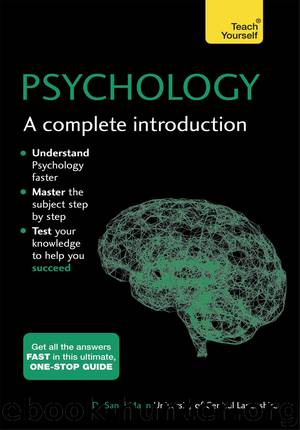Psychology- a Complete Introduction by Sandi Mann

Author:Sandi Mann [Mann, Sandi]
Language: eng
Format: epub
Tags: A Complete Introduction
ISBN: 9781473609310
Publisher: John Murray Learning. An Hachette UK company
Published: 2016-04-07T04:00:00+00:00
Spotlight: Monkey hatred
Despite Harlow being famous for his work with monkeys, he had a strong dislike for the primates and is quoted as saying, ‘The only thing I care about is whether a monkey will turn out a property I can publish. I don’t have any love for them. Never have. I don’t really like animals. I despise cats. I hate dogs. How could you like monkeys?’
THE INFLUENCE OF MARY AINSWORTH
Mary Dinsmore Salter Ainsworth (1913–99) was an American-Canadian developmental psychologist known for her work in early emotional attachment with the Strange Situation Procedure in 1965, as well as her work in the development of Attachment Theory. She developed the Strange Situation Procedure as a way of assessing attachment behaviour in young children. The investigative procedure is divided into eight episodes, all of which are observed through a one-way mirror:
1 The infant and his or her caregiver are introduced into a laboratory setting, filled with toys and two chairs. The caregiver interacts and plays with the baby.
2 After a minute the caregiver is asked to withdraw and sits quietly, not interacting as before, leaving the child to explore his or her surroundings.
3 After a further minute, a person unknown to the infant enters the room and at first, just observes, then slowly tries to engage with the child.
4 The first separation: the caregiver now leaves the child with the stranger for three minutes; this generally causes the child to become distressed and the stranger attempts to comfort them.
5 First reunion: the caregiver returns and is able to comfort the child and the stranger leaves.
6 Second separation: the caregiver departs for a second time, leaving the child entirely alone for three minutes, which is again expected to cause some anxiety.
7 It is then the stranger who enters and offers to comfort the infant.
8 Finally, the caregiver returns, and is instructed to pick up the child.
The reunions and separations are of particular interest to observers. On the basis of their behaviours, the 26 children in Ainsworth’s original Baltimore study were placed into one of three classifications. Each of these groups reflects a different kind of attachment relationship with the caregiver, and implies different ways of responding to perceived threats.
• Secure attachment: a child who is securely attached to its mother will explore freely while the caregiver is present, using her as a ‘safe base’ from which to explore. The child will engage with the stranger when the caregiver is present, and will be visibly upset when the caregiver departs but happy to see the caregiver on his or her return.
• Avoidant insecure attachment: a child with the anxious-avoidant insecure attachment style will avoid or ignore the caregiver – showing little emotion when the caregiver departs or returns. The child will not explore very much regardless of who is there. There is not much emotional range regardless of who is in the room or if it is empty.
• Resistant insecure attachment: children classified as anxious–ambivalent/resistant showed distress even before separation, and were clingy and difficult to comfort on the caregiver’s return.
Download
This site does not store any files on its server. We only index and link to content provided by other sites. Please contact the content providers to delete copyright contents if any and email us, we'll remove relevant links or contents immediately.
The Art of Thinking Clearly by Rolf Dobelli(10219)
Mindhunter: Inside the FBI's Elite Serial Crime Unit by John E. Douglas & Mark Olshaker(9200)
Change Your Questions, Change Your Life by Marilee Adams(7635)
Nudge - Improving Decisions about Health, Wealth, and Happiness by Thaler Sunstein(7615)
Mastermind: How to Think Like Sherlock Holmes by Maria Konnikova(7227)
The Power of Now: A Guide to Spiritual Enlightenment by Eckhart Tolle(5605)
Men In Love by Nancy Friday(5155)
Altered Sensations by David Pantalony(5045)
Factfulness: Ten Reasons We're Wrong About the World – and Why Things Are Better Than You Think by Hans Rosling(4694)
The Confidence Code by Katty Kay(4187)
Thinking in Bets by Annie Duke(4152)
Man and His Symbols by Carl Gustav Jung(4067)
The Worm at the Core by Sheldon Solomon(3435)
Why Buddhism is True by Robert Wright(3404)
Liar's Poker by Michael Lewis(3368)
Three Women by Lisa Taddeo(3354)
The Inner Life of Animals by Peter Wohlleben(3259)
Descartes' Error by Antonio Damasio(3230)
How Music Works by David Byrne(3186)
